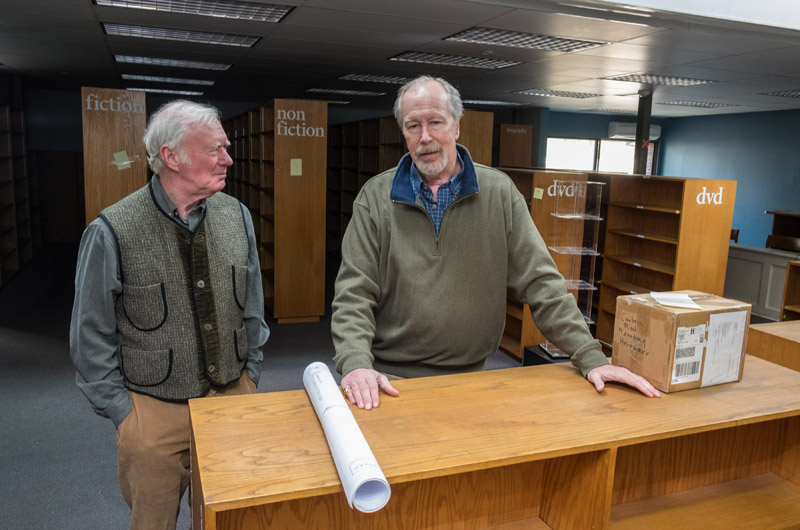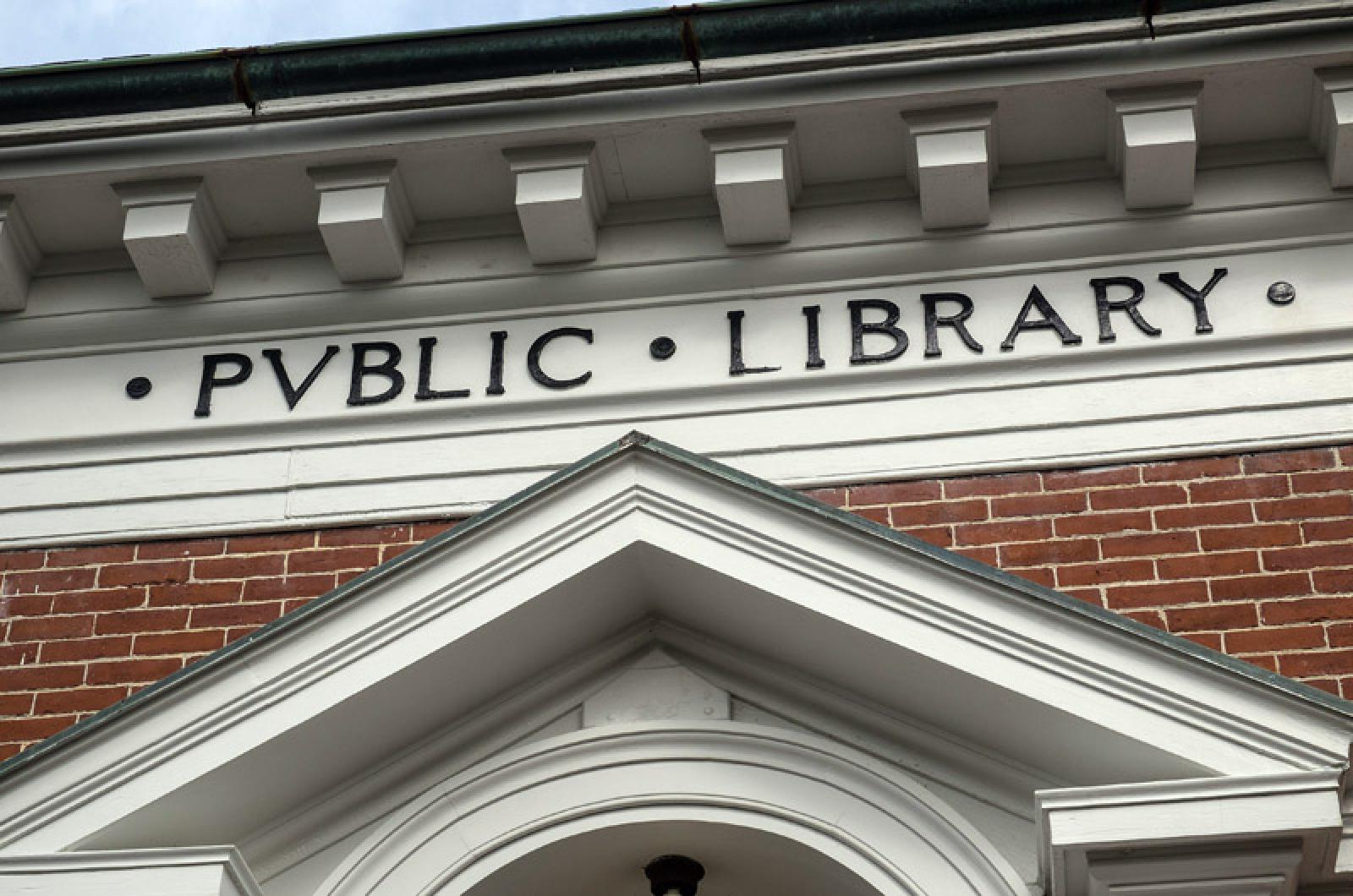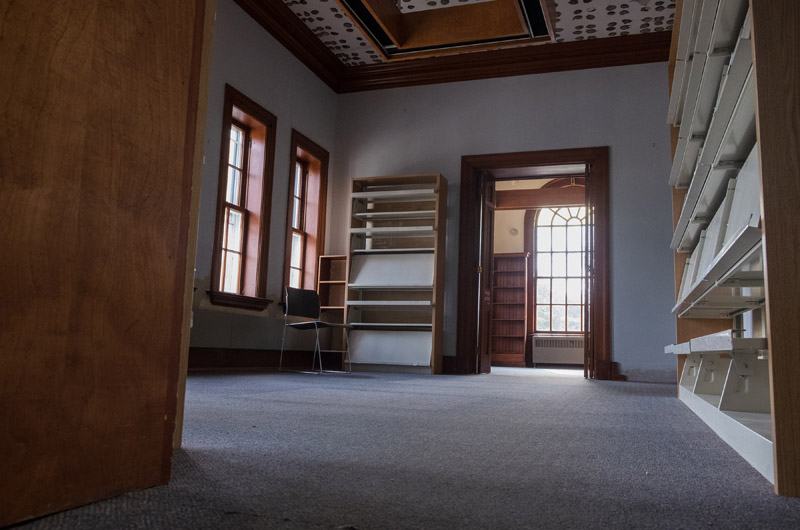Daffodils were blooming in front of the red brick Carnegie library building Wednesday when Martha’s Vineyard Preservation Trust executive director Chris Scott put the key in the side door and stepped inside the trust’s newest property.
Where others might see the remnants of the former Edgartown Library in the 112-year-old building, with empty shelves labeled Mystery and Fiction, a cleared circulation desk and lone telephone sitting on the floor, Mr. Scott and his colleagues see a reading room, displays, and exhibit spaces for their new project. In the months ahead the Carnegie building will be converted to a heritage center that will showcase the trust’s 24 historic properties around the Island and the stories they tell about the Vineyard.
“Right now there’s no place where people can get the story and then decide what they’re interested in seeing,” Mr. Scott said Wednesday during a tour of the building. He was joined by Matthew Stackpole, a maritime historian and West Tisbury resident who is working with the trust to develop the center. Mr. Stackpole recently served as the ship historian and major gifts officer at Mystic Seaport for the whaling ship Charles W. Morgan’s 38th voyage.

The preservation trust’s stewardship vouchsafes a bright future for the stately town building that until March 4 housed the town library. The library is now housed in a new, larger building next to the Edgartown School.
“We want everyone who has that sentimentality about the Carnegie to be able to come in here and enjoy it,” Mr. Scott said.
Steel magnate and philanthropist Andrew Carnegie was a seasonal Edgartown resident around the turn of the 20th century, Mr. Scott said, and he later named Edgartown as one of thousands of communities to receive Carnegie funding for a public library. The brick building was constructed in 1904 on land donated by Caroline Osborn Warren, a descendant of the Edgartown Osborn whaling family who lived next door.
The building was expanded twice through the years but eventually the town outgrew the old library, which lacked parking and enough space for modern needs. When funding came through to build a new library, the preservation trust expressed interest in the building. Last year at town meeting Edgartown residents unanimously approved a measure that would hand over the library to the trust.
Earlier this week the deal was formalized as Mr. Scott gave selectmen a $1 check for the old building and the preservation trust got the keys. The trust launched a successful capital campaign for the project last year, Mr. Scott said, and has raised a substantial amount of money for the heritage center, although he declined to make the amount public yet.
On Wednesday Mr. Scott and Mr. Stackpole got a close look at what they are working with.
The front of the building, where large windows topped with fan details let in light and wood paneling lines the walls, will likely be used as a reading room and library housing a collection of what Mr. Scott called “Vineyardiana.” A collection of maritime literature, books about the Vineyard and Edgartown, and books by Vineyard authors are all contemplated for the collection. Partitions dividing the front rooms from an entryway will likely be removed.
Parts of the building added on in 1938 and then later in the 1970s will be used for exhibits and information about preservation trust properties and related Island history.
Other Edgartown properties owned by the trust include the Federal style home built by Dr. Daniel Fisher, a whaling ship owner; the Norton boathouse, the last sea captain’s and fisherman’s boathouse on the harbor; the pre-Revolutionary-era building on South Summer street that houses the Vineyard Gazette; and the Old Sculpin Gallery, where Manuel Swartz Roberts operated a wooden boat shop. The trust also owns the Edwina B., one of Mr. Swartz’s catboats.
Other trust properties around the Island include Alley’s General Store in West Tisbury, the Flying Horses Carousel and Union Chapel in Oak Bluffs, and Slip Away Farm on Chappaquiddick.
The properties span major periods of social activity on the Vineyard, Mr. Scott said, from farming to whaling, fishing and yachting, agriculture and tourism. The goal of the new center is to use trust properties, and more information about their histories, as a portal to parts of Vineyard history.
“It’s such a great vision,” Mr. Stackpole said. “That’s the great thing about this Island — it reflects so many parts of human history. We’ve got it all here, so let’s flaunt it. Let’s celebrate it.”
Mr. Scott and Mr. Stackpole have taken guidance from the Penobscot Marine Museum in Searspoint, Me., where Mr. Stackpole’s brother is the former director. They’ve also visited the Nantucket Historical Association and New Bedford for a look at “how different communities present themselves and how visitors get the story,” Mr. Scott said. The heritage center will complement existing Island resources, Mr. Scott said, including the Martha’s Vineyard Museum and its collections.
Architect Patrick Ahearn, a trust board member, is working on plans for the building. Renovations will focus solely on the interior, with exterior walls left alone. Renovation work will likely begin this summer. “We want to take our lead from some of the components of the original building and then bring them through,” Mr. Scott said. He added that “getting rid of the 70s and 80s” might be a priority.
The trust will work closely with exhibit designers to make the newer back portion of the building suitable for exhibits. Mr. Scott is hoping to find hardwood flooring under the carpet.
A collection of artwork by the late Ray Ellis is planned for the new center.
And plans for the Carnegie building will stay true to the preservation trust mission of using historic properties for their original intended uses.
“What is a library? A library is a portal into knowledge and being exposed to things, and that will happen here,” Mr. Stackpole said. “It will be different, a variation, but the spirit of it is the same. There’s a continuity of mission.”
Mr. Stackpole said he sees continuity with the Charles W. Morgan project, which ended when the 170-year-old ship sailed again two years ago.
“The fragility of history is all around us,” Mr. Stackpole said. “To have something that’s live, like the Morgan . . . . look at the changes all around us. Around the Island are these places that are still here, still functioning as a vital part of the community, and it’s because of the trust,” he added.
“It’s a broad effort,” Mr. Scott said.
“Here we are, right here at the beginning,” Mr. Stackpole said in the library Wednesday. “What a thrilling thing to be a part of.”
Before taking stewardship of new buildings, Mr. Scott said: “You kind of have a vision, talking about a property, what it’s going to be. And that phase of the process ends and then you put the key in the door for the first time and you walk in and say ah, goodness, there’s a lot of work to be done.”
But looking at the Carnegie, he said: “I actually can kind of see what it’s going to look like in my mind’s eye.”









Comments (2)
Comments
Comment policy »